 |
Trip to the Klein Matterhorn (3883m)

I remember clearly the fantastic feeling I had when I went to the head of the train: one simply has to get into the train from the down side and get out after approximately 15 minutes at a height of 3000 m. At that time, I thought it won't be possible to get higher, but shortly afterwards, I went up the Jungfraujoch from the Grindelwald and was therewith further 500 m closer to the sky. Now, it is really not possible any more to get higher without climbing, is it? It is, Chamonix takes their visitors up to a height of 3842 m, in order to gaze at the roof of Europe, the Mont Blanc.
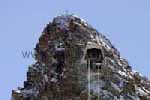
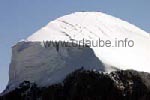
But the "Top of the Tops" is in Zermatt: by going from Zermatt with the glacier express to Furi and from there with the big gondola to the station Trockener Steg at a height of 2939 m, then, one already reached the height of Germany's highest mountain, the Zugspitze. From there, the aerial cableway starts to the Klein Matterhorn, that takes one at a height of 3820 m. The trip with this gondola is impressive and freightening at the same time: it floats up over the valley and one is barely able to calculate the distance to the ground. One should not even think that the cable could break. But then one repeatedely does hear any time how this huge gondola drives over a supporting mast and swings thereafter, there are screams and noises as on a roller coaster after a looping.
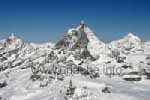
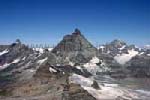
The gondola has a speed of 10 m/s, thus 36 km/h upwards; the peak of the Klein Matterhorn comos closer and closer. But where is the gondola supposed to stop, there is no station at sight yet? The station has been built into the mountain, the gondola practically goes into a hole in the northern wall of the Klein Matterhorn. What an arquitecture has been done here by the Swiss people! But one can also expect something spectacular, as one finally paid approximately 50 € per person for the trip up and down; for this money, there are already flying tickest from Munich to London available!

At a height of 3820 m, the gates of the gondola open and most of the tourists that started from Zermatt wearing shorts and t-shirts get at first a cold shock. As, when down in Zermatt, there are 25°C, at a height of nearly 4000 m on the Klein Matterhorn there are barely 5°C, and this is cold, even if the sun radiation is intensive. Thus, those who also want to enjoy but not only survive an excursion to the Klein Matterhorn, should in any case take some long trousers, closed shoes and a coat with them, even if down in Zermatt, there are midsummery temperatures.
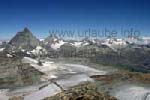
Apropos down in Zermatt: Is it allowed at all to say in relation to a place like Zermatt down? From the German point of view, one should, for a place that is located at a height of 1620 m rather use the words above, up, mountain village, but this is the way it is if one is taken to a height of 3800 m.
Immediately after getting out of the gondola, one discovers the next architectural masterstroke of the Swiss people: life takes place at the souther hill and not at the north hill, where one arrived. Thus, the Swiss people simply built a tunnel through the mountain. Thus, at the very top, one simply walks approximately 60 m underneath the peak through the mountain. On half-way, there is even a turn in the tunnel, from which one gets to a lift that takes one further 50 m higher. Thereafter, one has to ascend some stairs and then one gets out to an observation deck at a height of 3883 m . For simple pedestrians, this observation deck is really the roof of Europe; from here, it is really only possible to get higher with the respective climbing equipment.
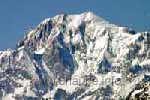
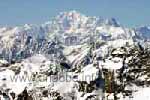

There really only one hundred meters to walk through the tunnel, and also barely 100 stairs to ascend from the peak lift up to the observation deck, but on these metres some visitors run out of puff and some unexperienced visitors also get circulation problems. It is not not everyone's cup of tea to gain nearly two and a half thousand altitude difference within half an hour. In order to do something good for the health, I recommend to enjoy the dream views for a while after arriving at the station Trockener Steg, before continuing with the remaining 900 metres altítude difference. The restaurant "Trockener Steg" is very suitable to have a short coffee or tea break in.
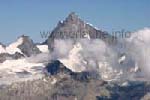
The fact that from an altitude difference of nearly 3900 m, one has a fantastic view, is nearly not neccessary to mention. It is almost a 360°-panorama-view, but only almost, as the neighboured peaks, the Breithorn, covers a part of the sight in eastern direction. The Breithorn, that automatically attracts the view of the visitors of the observation deck, is 4164 m high and is considered to be the easiest four-thousander peak of the Alps. Where this title comes from is obvious by watching the masses of mountain climbers that assault the Breithorn-summit: at a height of 3800 m, they start at the "rear exit" of the Klein-Matterhorn-tunnel, so that there is still an altitude difference of "only" 350 metres to walk.
Those who observe the Breithorn-climbers with the binoculars will be aware that this walk at an altitude of 4000 m is pretty draining. It is, indeed, a harmless hiking in the snow, where little groups always string together, but a few steps at a height of 4000 m are simply something different as in the city.
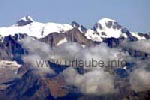
Now, of course, the view to the Matterhorn, as one seems to be almost equal to it in concern of the height, but still 500 m re missing. But what kind of mountain is this, is the Matterhorn really visible? On the observation deck, there are boards all around, that display the names of the summits of the mountain panorama. In fact, the stony, not speacially nice looking pyramid right in front of one is the so much admired Matterhorn. Where is the beauty of the mountain gone, that makes it to be so famous? From the Klein Matterhorn, a top of a pyramid is visible, that does not differ considerably from its neighbour summits as the Dent Blanche or the Weisshorn.
At this point it gets evident that the Matterhorn is not a fairytale mountain but a "complete normal" Four-thousander, that is located amidst a great high mountain region. THe juicy meadows and green forests that people like to pack together with the Matterhorn on a picture in order to provide the picture with more colour and nature, a far below one and practically not visible.
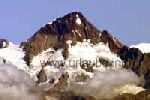
What is much more fascinating than the Matterhorn is, at a clear day, the almost endless summit panorama that one can see from the Kleinmatterhorn. By looking in southern direction, the Gran Paradiso appears, heighted 4061 m. After a little pan to the right, the shape of the 4807 m heighted Mont Blanc appears at the horizon. If the day is clear, the highest mountain of the Alps seems to be a stone's throw away. But if one looks closely to the mountain chains between the Klein Matterhorn and the Mont Blanc, one sees that there are some valleys between the mighty mountains before the Mont Blanc majestically rises to the sky.
And of course, from here above, it is most easy to imagine how the Theodul Pass once served as a north-south transit-axis. It seems to be almost easy to walk up the Theodul Glacier in order to descend at the other side into the Aosta Valley.
With the help of the boards, each single mountain of the Zermatt area can be identified and recognized. But what I was not aware of until my second visit to the Klein Matterhorn summit is that one can look over the Matter Valley away up to the Berner Alps. On a clear day, I recognized all the famous summits as the Bietschhorn, the Aletschhorn, Eiger, Mönch and Jungfrau. I guess, that the air line distance is of approximately of 50 km.
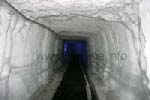

The reason why we went up to the Klein Matterhorn for a second time has to do with the weather. One has the clearest sight after a coolish night in the matutinal coldness. Already during the forenoon, the first heap clouds form in the mountains and the sight is affected. The earlier one gets to the summit, the bigger is the possibility to be able to enjoy some perfect panorama views.
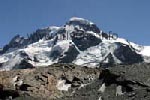
I guess that any time, we spend one hour at the roof of the Klein Matterhorn, as I was so impressed by the clear views. After visiting the observation deck, one gets to the other end of the tunnel where one arrives to the big glacier where there is the biggest summer ski area. Here, those who cannot stand a summer break are skiing and snowboarding; here, some Japanese put the skiers on, in order to take a nice picture of them home; but here, also the professional sportsmen do their training for the comming winter.
As a "simple" visitor, a glacier grotto is waiting for one, in which one gets into through an ice tunnel. The fact that in an ice grotto amidst a glacier, the temperatures are around the freezing point, should be self evident. It is a queasy feeling to submerge amidst the glacier, to walk there through the subterranean alleyways and gaze at sculptures and little lateral grottos of ice.
Those who did not do any stop during the ascend to the Kleinmatterhorn, should have a coffee break latest during the return trip in the station "Trockener Steg" at a height of 2939, as from here, one can look up again unhurriedly and see where one has been during the latest one or two hours.

Back to the index Zermatt
Copyright: Patrick Wagner, www.tourist-guide.biz
|
 |